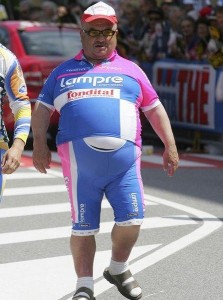
I have seen a lot of websites giving advice to cyclists, from bike fit, to technique, however none seems to apply specifically to people who are obese.
Being obese brings its own problems, from bike fit, comfort, to even just being able to get started and help your partner getting into cycling.
I have been both really obese, and slim, and cycled. I have helped a few people into cycling, and also seen some people put right off by over-enthusiastic friends trying to get people into it. Hence the reason for this post, just in case you are larger and need advice, or are helping somebody larger.
Getting the Bike & Bike Fit
When starting out, most people need comfort. If it’s a painful, or uncomfortable experience, they will not want to repeat it!
The bike fit is NOT the same as a normal person! You will need a stronger frame than usual, I would suggest alloy (lighter), or if you are particularly heavy, Steel. Don’t waste money on cheap bikes, get a good brand name bike, even if its second hand. Cheap bikes fall apart, often are not comfortable. Carbon is probably not ideal for heavy weights, its flexible and will crack.
A hybrid is a good option as it has a more upright way to sit, larger tyres, and better seats. Make sure you have 3 cogs on the front, you will need these for any sort of hill (be it mild or otherwise), and it will help stop you getting sore knees from hauling the extra weight.
Road Race bikes are not great for first timers, the fit is fairly aggressive which can put far too much weight on your arms (stomach pulling you forward), and not allowing you to breath when pedalling due to knees hitting belly.
Make sure the seat is as high as you can handle, as this keeps knees from hitting belly as much as possible, also helps with pedalling. Make sure you explain this to the person riding as it will feel weird at first, if they understand the why they will tolerate it much better.
Handlebars need to be higher than seat if you can, feel free to buy an Adjustable Stem so you can raise them higher to begin with, taking weight off the arms.
Make sure the seat is a larger (but not stupidly large) seat, preferably with Gel. Whilst thinner smaller seats are our goal, when you are larger this can cause back pain due to any road bumps travelling up the spine with the extra weight involved. Having a more padded seat allows not just the sit bones, but the rest of the buttocks to spread the weight over a larger surface. This means no one point is going to get sore, though it may cause chafing. If you can find a larger seat with good sized cut out, this should solve the problem. Mountain bike seats are good for this.
Starting out
When starting out, its good to find a good flat long ride, aim for 5-10km and what ever pace they prefer. Make sure the lower gears are used at all times, and spinning with very little weight is encouraged. It’s everyones tendency to grind a bit when beginning, using harder gears, but when a larger person does this it can very quickly end up hurting knees and other joints.
Spinning is a good habit, and it places the work on the cardiovascular system rather than the leg muscles. This allows them to get fitter faster, and enjoy the ride with less pain.
Make sure you accompany them on all rides, talk to them about anything and everything under the sun to distract them from what they are doing. Don’t push them into doing anything fancy, just let them get a few easy rides under their belt at their own pace.
If a person finds riding painful, hard, or boring, they are not going to do it again.
Avoid hills until they are ready to go on them, its extremely hard to do hills when larger, this is where those lower gears will be needed. Most newbies are also fairly scared of having to start riding on a hill, or going down hills fast. Make sure the hills are barely there to start with, and you give them options for if they need to bail.
The last thing you want is them to feel like a failure!
Make sure you have good gaps between cycling days at first, until their body has adapted and is not sore. Nothing is worse than going cycling 2 days in a row when you have chafing or soreness somewhere. By wearing cycling smart watches they can check the number of kilometers they have cycled, and this intern boosts the self-confidence and makes them feel better.
Moving on
Encourage them to have a local loop they can do by themselves, and then do larger rides with them. Put the bike computer in your back pocket to avoid clock watching, see their face when they are pleasantly surprised by how far they went.
Look into getting some Bone Conduction headphones, they can be used when cycling since they do not block your ears (I found aftershokz brand for $30-40 on amazon.com). This enables a person to ride solo and listen to music whilst cycling alone, with less chance of boredom.
Enter some races which are achievable, work out a plan to train for it, and allow for weeks when a bike may break, person maybe over tired or other problems.
Remember, you may have spokes break. Extra weight on a bike will eventually break spokes, its worth getting a professional to replace them and true up the wheel as soon as this happens. If the wheel is not fixed correctly, the weight is not distributed over the entire wheel and other spokes will break costing you more in the long run. Be aware to check for broken spokes every ride or two, not noticing them will result in an egg shaped wheel that may need replacing!
Hydration
Buy a backpack, camelbak or similar with water. Its easier to hydrate when learning, and carries a lot more water than a bottle. Larger people will need a lot more water to begin with, and the weight difference isn’t going to be noticeable. Pays to get one with bumps on the back so air can flow between the bag and your back if you can, but not necessary.
Clothing
Cycle shorts with padding are a must, and its worth splurging on decent ones (though not necessarily expensive ones). Make sure you let them know its fine for them to wear baggy shorts or 3/4 pants over top of the shorts – most larger people are very aware they have a super sized rear which probably looks less than desirable in lycra 🙂
For the top half, a T-shirt may be more comfortable and look more flattering. Back pockets are not essential, get a bike bag for anything you need to carry. Most newbies are not adept at getting things from pockets when cycling anyway (especially when wearing a water pack on their back).
Bike Computers
Get a cheap one with cadence, since cadence is more important at this stage than anything much else. Otherwise go without, and have them keep their pedalling timed with your own. I have had a friend sit behind me and just make sure shes pedalling the same speed as me, and adjusting her gears to match which worked well, this also helped her stop clock watching.
The Bottom Line
Make the experience as pleasant as possible, even if it means gritting your teeth to not say something. The better the experience, the more likely they are to stick with it and get better. Compliment them on anything and everything they do well. Don’t force them into doing things they do not feel comfortable (hills, busy roads, groups) until they are ready for it, and give them an opt-out solution in case they change their mind last minute (eg short cuts around hills)
Show them the wonder of cycling, how amazing it feels, and how great you feel when cycling!

